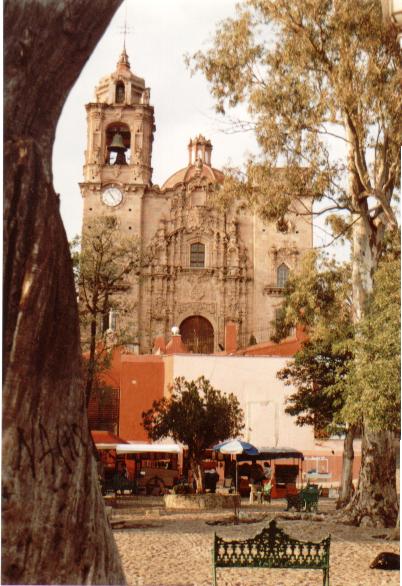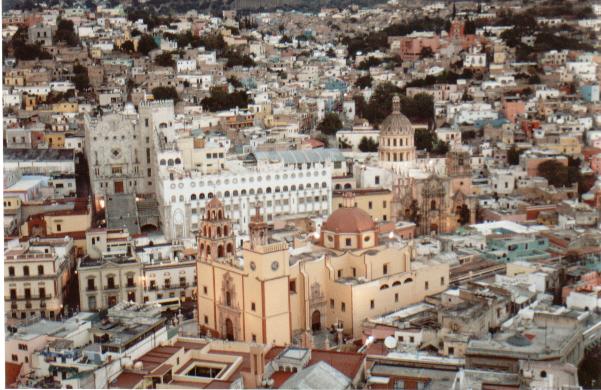|
De Guanajuato y otras cosas locas
Amigo lector, la historia de nuestro país está llena de lugares y acontecimientos insólitos,
de esos que a primera vista parecen pequeños e incluso carentes de interés, pero que en la
práctica representan los verdaderos cimientos de nuestra identidad como mexicanos.
Guanajuato es uno de esos lugares extraños que por su arquitectura podría estar ubicado
en cualquier ciudad medieval de Europa. Ubicada en el bajío mexicano, Guanajuato está
rodeado de cerros y montañas que circundan una cañada en forma de tazón, en cuyo fondo
se encuentra fundada la ciudad. Su clima es templado, su vegetación característica es
de tipo semidesértico en las planicies y laderas, con bosques de coníferas y otras
maderas en las cimas de las montañas que rodean a la ciudad. Enclavada en el centro
del país, se encuentra a tres horas de la ciudad de Guadalajara y a cuatro de la
capital de la República, la Ciudad de México. Capital del estado del mismo nombre,
actualmente es cede de sus poderes Ejecutivo, Legislativo y Judicial, aunque varias
dependencias descentralizadas se encuentran ubicadas en diversas ciudades del estado.
También en Guanajuato se encuentra la célebre Universidad, cuya historia se encuentra
íntimamente ligada con las ya tradicionales estudiantinas y callejoneadas.
Guanajuato es famoso por muchas cosas, pero principalmente, existen tres atractivos para el
turista común y corriente:
- Sus minas y socavones, algunas de las cuales están abiertas al público.
- El museo de las momias, donde se exhiben cadáveres humanos momificados naturalmente, y
- El Festival Internacional Cervantino, magno evento cultural que se lleva a cabo cada año en
el mes de Octubre, y que atrae a artistas y visitantes de todas partes del mundo.
Sin embargo, Guanajuato es más que una ciudad de momias y estudiantes. Su peculiar
arquitectura es por sí sola un buen pretexto para visitarla; de hecho, esa arquitectura,
sin sentido ni orden aparente, cumple con funciones muy especiales: en los primeros años
de la ciudad, y hasta apenas las primeras décadas de este siglo, Guanajuato sufría constantes
inundaciones por las periódicas crecidas de agua de los ríos que lo rodean (como el río
Guanajuato, Laja, y otros más), que en las temporadas de lluvia se desbordaban, haciendo
correr sus aguas frenéticamente hacia el fondo de la cañada en donde se encuentra la ciudad.
Esas constantes inundaciones iban acompañadas de grandes piedras y mucho lodo arrastrado de
los cerros, que con frecuencia sepultaba total o parcialmente a las construcciones más bajas
en el centro. Pero, debido a la riqueza de los minerales encerrados en las entrañas de las
montañas que rodean a la ciudad, sus moradores, lejos de reubicarla, la reconstruían sobre
las ruinas de la ciudad anterior, que sepultada en el lodo y las piedras, creaba verdaderas
cápsulas del tiempo en donde se resguardaban construcciones, objetos, y momentos de la historia.
Guanajuato es como una cebolla, con muchas capas debajo de la superficie. De hecho, todos
los edificios del centro, particularmente aquellos construidos a lo largo de la Avenida
Hidalgo (antiguo cauce de desagüe construido para librar a la ciudad de la furia de las
aguas, que por este medio eran conducidas a la actual Subida de Pozuelos y hoy conocida
como Calle Subterránea) tienen enormes murallas de más de cuatro metros de altura desde
el nivel del piso hasta el nivel donde se encuentra el primer piso de las casas. Esas
murallas, en algunos puntos de la calle, muestran viejos arcos cegados, nichos oscuros
y olvidados, y rincones que demuestran que ahí, debajo de aquellas extrañas construcciones,
se encuentran cuartos olvidados por el tiempo y los hombres, en donde el pasado deambula
silencioso por sus oscuros entornos, esperando....
Existen varias leyendas en Guanajuato relativas precisamente a aquellos cuartos y pasajes
secretos, olvidados de la gente. Una de esas leyendas habla del músico que fue contratado
por el diablo para tocar en un elegante salón subterráneo, o de los monjes fantasmas que
deambulan por las crujías y las antiguas celdas sepultadas del antiguo monasterio de San
Diego, o la versión local de La Llorona, que dicen se aparece en los túneles que conducen
a Alonso y al Jardín Unión...
Curiosidades de Guanajuato
(o noticias del arcón de los recuerdos)
- La famosa "Calle Subterránea", formalmente conocida como Calle Miguel Hidalgo, fue inaugurada a finales de los años ´50, y sigue el cauce del antiguo río que atravesaba la ciudad.
- La Calle Subterránea fue construída con tres objetivos en mente: Proporcionar una vialidad que descongestionara el centro de la ciudad, encauzar el río que servía como el canal de desagüe principal de la ciudad y que todavía en la primera mitad del siglo corría a cielo abierto, y proporcionar a la ciudad un atractivo turístico más.
- En 1976 se concluyeron las obras de los túneles de desagüe que desde entonces evitan las constantes inundaciones que la ciudad sufrió en el pasado.
- Guanajuato es cede de los Festivales Internacionales Cervantinos, que año con año se realizan ininterrumpidamente desde 1972 en el mes de Octubre.
- El Panteón Municipal, célebre por el extraño y escalofriante fenómeno de la momificación natural de los cuerpos enterrados en él, ha sido utilizado por más de 100 años. En la década de los ´50 fue ampliado y remozado, agregándole tres nuevas alas de nichos.
- Durante mucho tiempo, el mejor medio de comunicación de la ciudad con el resto del país fue el ferrocarril, el cual llegaba a la antigua estación en el barrio de Tepetapa. Sin embargo, desde hace casi cinco años ya no llega el tren a Guanajuato, porque ahora es más fácil y rápido accesar por carretera.
Por ahora, dejaremos aquí el relato de las principales características de esta extraña ciudad, con la promesa de continuar pronto describiendo este paraíso del turismo, los intelectuales, los fotógrafos, y en general, de cualquier mexicano de con justicia se puede sentir orgulloso de que en su Patria se encuentre esta bella ciudad, nombrada Patrimonio Cultural de la Humanidad por la UNESCO.
Hasta pronto!!!

Otorgado el 30 Sep 1998
|
Of Guanajuato and other crazy things.
Dear reader, my country´s history has plenty of places and moments out of the common, those who at first sight might seem small and boring, but in reality represent de very fundaments of our Mexican heritage.
Guanajuato is one of those little places which because of its strange architecture could be mistaken for any european medieval city . Located in the middle of Mexico, Guanajuato is in the middle of mountains and hills that surround a valley with the form of a bowl. The city is located in the bottom of that valley. Its climate is cool, its typical vegetaton is composed of semidesertic plants in the valleys and low hills, and forests in the mountains.
You can drive to Guanajuato from either Guadalajara or Mexico City. From either place, it will take you no more than four hours to get to this crazy place, seat of the Government of the state. In Guanajuato you will also find the famous Universidad, institution whose history is closely interwoven with the famous and traditional Estudiantinas and Callejoneadas.
Guanajuato is famous worldwide for many things, but there are mainly three principal attractions for the common tourist:
- Its mines, like Valenciana, Cata, Rayas and so on, many of which are open to the public.
- The cementery museum, where you can see mommified corpses created by the mineral action of the special soil of this place, and
- The Internacional Cervantino Festival, or FIC, a very important and famous festival plenty of culture, music, theatre and dance, which is held every year on the first two weeks of October and that draws artists and tourists from around the world.
But Guanajuato is much more than a city of students. Its architecture is by itself a very valid reason to visit it; as a matter of fact, this strange architecture, though at first sight might look senseless and messy, has a very important function: from the beginings of the city, until well into this century, the city has suffered from severe floods caused by the severe rains that made the rivers that surround it flow out of their beds. Thus the water often ran into the city, which was covered by stones and mud that buried many buildings. But its inhbitants, rather than moving to another place, rebuilt several times their houses over the remains of the old buildings, creating a city that might be compared to a onion, in which several layers lay under the outher surface. As a matter of fact, many old buildings, but particularly those located on the Hidalgo Street (now better known as the Underground Street) have foundations rising up to four or five meters above the street level, and in some places you still can see covered arches, niches and corners that show that, under the present buildings, lie many other old buildings, with rooms, windows, doors and aisles, and in many places the actual objects of a forgotten past, inhabited only by the ghosts of the old tenants, who wait patiently, still immersed in their own century, well under the present inhabitants of the buildings...
There are several legends here in Guanajuato regarding to those rooms and hidden passages, forgotten for all but for the old ghosts. One of those legends tells of the old musician who was hired by the devil to play on an elegant underground room, or the ghosts of old monks who walk silently on the buried rooms and cells of the old San Diego monastery, or the local version of the Weeping Woman, which popular belief says can be seen on the tunnels bound to Alonso Street and Union Park...
Guanajuato Bits
(or the news unburied from the past)
- The famous Underground Street, formally known as Miguel Hidalgo Street, was inugurated on the late 1950s. It follows the bed of the old Guanajuato river, that used to run in the middle of the city.
- The Underground Stret was built with three objectives in mind: Create a new causeway to desentangle the traffic on downtown Guanajuato, sanitice the city covering the old sewer river that used to run on the surface, and give Guanajuato a very unusual street that could be considered one of its most interesting attractions.
- In 1976 the last drainage tunnel was finished, and ever since Guanajuato has been free of the constant floods that used to cover it.
- Guanajuato has been the seat of the Festival Internacional Cervantino, that has been held every year since 1972.
- The Municipal Graveyard, famous because of the natural mommification of many of the corpses buried there, has been used for more than 100 years. On the late 1950s, it was enlarged and embelished, creating three new wings full of niches for the new "tenants".
- For many years, the better way to arrive to Guanajuato was by railroad, which used to arrive at the old station located on the Tepetapa colony. But for almost five years, the railroad doesn't arrive to Guanajuato anymore, because today is easier and faster to get here by car using the modern freeways.
... That´s all for today, folks. We will continue describing this strange city, nominated by UNESCO as a Worldwide Heritage Site. For now, we hope you have enjoyed this small story about one of the most beautiful cities in México, and we hope we will see you soon there.
So long!!!

|




